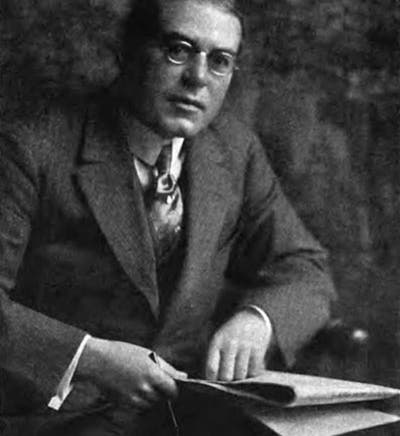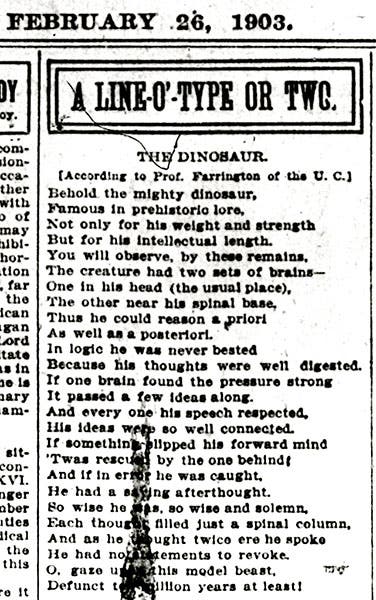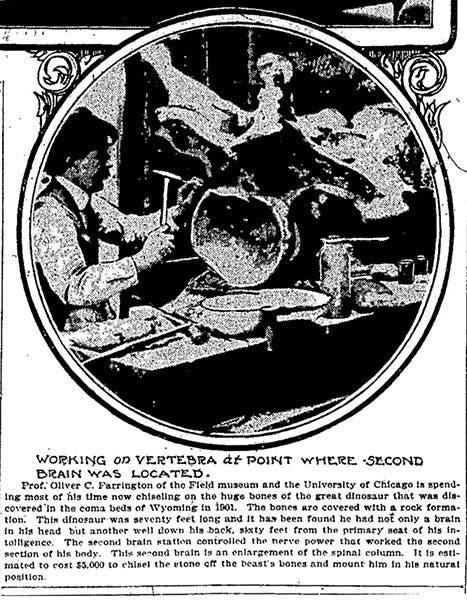Scientist of the Day - Bert Taylor
Bert Leston Taylor, an American newspaper writer, was born Nov. 13, 1866. Taylor invented what pressroom gurus call the "colyum"--a newspaper column salted with clippings, quips, poems, and contributions from readers. Taylor wrote for the Chicago Tribune from 1901 to 1921 (with six years off in New York), and he called his column "A Line o' Type or Two." One of the poems that he wrote for his column has become legendary in paleontology circles, although its inspiration is often misunderstood and the supposed date of composition incorrect. The poem was inspired by a recent proposal that the dinosaur's tiny brain might be augmented by a second brain at the end of its spine, suggested by large cavities found in some of the vertebrae. This was all Taylor needed to know, and he dashed off this for his column (there were no stanzas in the original – they were added here to make it easier to find and keep your place):
Behold the mighty dinosaurFamous in prehistoric lore,Not only for his weight and strengthBut for his intellectual length.
You will observe by these remainsThe creature had two sets of brains—One in his head (the usual place), The other in his spinal base.Thus he could reason a prioriAs well as a posteriori.
In logic he was never bestedBecause his thoughts were well digested.If one brain found the pressure strongIt passed a few ideas along.And every one his speech respected,His ideas were so well connected.
If something slipped his forward mind'Twas rescued by the one behind;And if in error he was caughtHe had a saving afterthought.So wise he was, so wise and solemn,Each thought filled just a spinal column,
And as he thought twice ere he spokeHe had no judgments to revoke.Oh, gaze upon this model beast,Defunct ten million years at least!
If you look up Taylor’s poem in most places, you will be told that the column appeared in 1912 and was inspired by the pea-brained Stegosaurus. We are indebted to a geologic sleuth, David B. Williams, for setting us straight. In 2013, Williams went through the issues of the Chicago Tribune and found that the poem “The Dinosaur” appeared in the column for Feb. 26, 1903, not 1912 (second image). Williams further discovered that the day before, Feb. 25, 1903, the Trib had run a story about Oliver C. Farrington of the University of Chicago, who, examining the vertebrae from a recently discovered Field Museum dinosaur, found a cavity on the spine that might hold a second brain. The paper even had a photo of Farrington at work (third image).
However, the dinosaur under scrutiny was not a Stegosaurus but a Brachiosaurus, which Field Museum fossil hunters had unearthed in 1901. Indeed, Taylor had given due credit, just above his poem, with a parenthetical “(According to Prof. Farrington of the U.C.)”. It is of some interest that the Brachiosaurus skeleton that inspired Taylor’s poem was later mounted and stood for many years inside the entrance to the main hall of the Field Museum (fourth image), before yielding the floor to “Sue.” An all-weather cast of the skeleton now stands outside the museum. Someone should affix a bright yellow arrow pointing to the hollowed-out vertebra that attracted the attention of Farrington, the Chicago Tribune, and Bert Taylor.
Now that we have Taylor’s original column to look at, we realize that many modern printings of the poem are incorrect – some have changes to the wording, and most versions contain the two lines: “No problem bothered him a bit/ He made both head and tail of it,” which is clever, but not part of the original poem of 1903.
Taylor was not a one-poem wonder. He also wrote “Canopus,” which appeared in his column “sometime” in 1919, it is said. The poem discusses the general subject of politics and the eternal bickering it provokes, and a star, Canopus, that lies outside all this. I reprint just one stanza here to show you that Taylor had not lost his touch in the 16 years since “The Dinosaur.”
For after one has had about a week ofThe argument of friends as well as foes,A star that has no parallax to speak ofConduces to repose.
We will defer reproducing the rest of the text of “Canopus” until some other literary detective has run it down in the archives of the Chicago Tribune, and perhaps has also discovered that, the day before, the Trib had reported on an attempt to measure the parallax of Canopus, an attempt that was, we would gather, unsuccessful.
Dr. William B. Ashworth, Jr., Consultant for the History of Science, Linda Hall Library and Associate Professor emeritus, Department of History, University of Missouri-Kansas City. Comments or corrections are welcome; please direct to ashworthw@umkc.edu.









